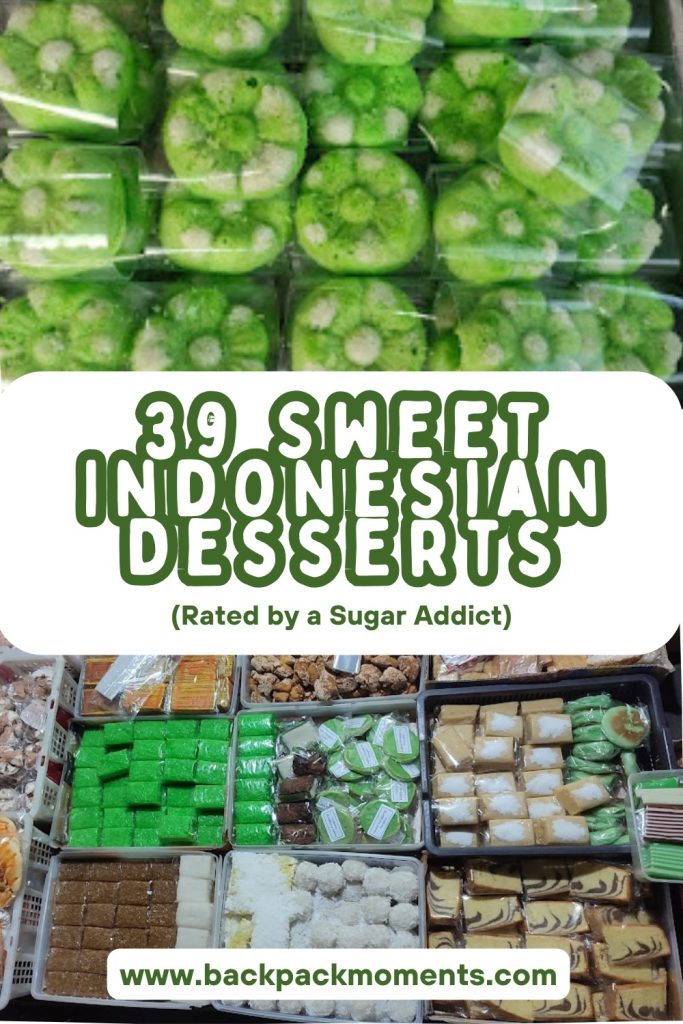39 Sweet Indonesian Desserts: Rated by a Sugar Addict
Indonesian food is a blast! All those nasi gorengs, mie ayams, sate kambing, and bakmi jawas really spoil the tongue. But what do you do when you finish your main meal?
You go for a dessert of course! And Indonesia has plenty of those!
After searching far and wide for all sorts of Indonesian desserts, I compiled this ultimate list of 39 of them.
I have tried every single one of these desserts in Indonesia and rated them based on their taste on a very subjective and personal 10-point scale.
Let’s get a sugar rush!
Fun fact: Dessert in Indonesian is “hidangan penutup” which translates to “closing dish“.
Packaged Indonesian Desserts
Let’s start with the desserts that come in some form of protective packaging, enough so that you can bring them back home. In other words: perfect for presents!
1. Bakpia
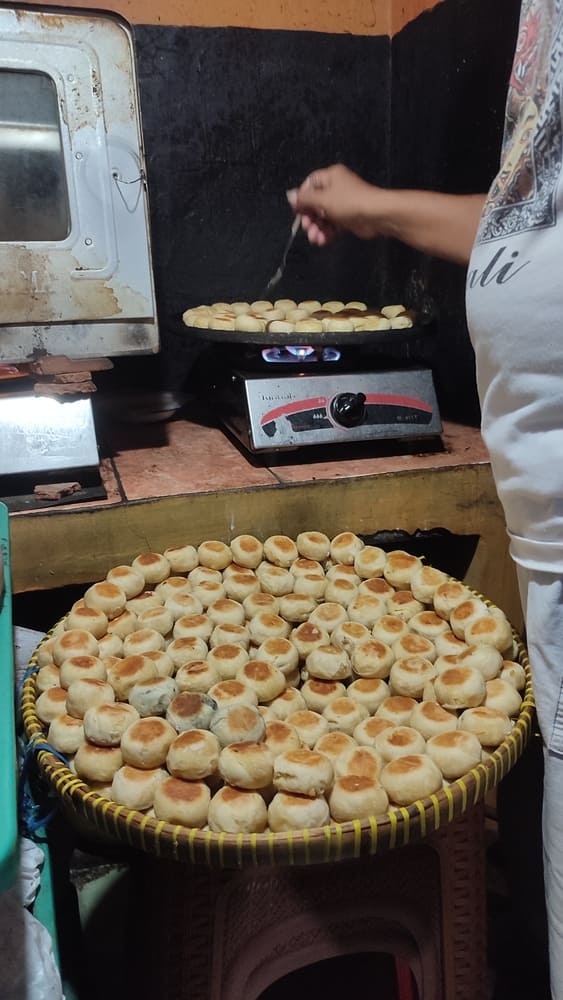
Bakpia consists of a thin, flaky pastry shell with various possible fillings. The most traditional and popular filling is mung bean paste, which is sweetened and sometimes flavored with ingredients like vanilla or green tea.
Other common fillings include chocolate, cheese, or even durian for a more exotic twist.
The pastry shell has a delicate, crumbly texture. Bakpia are small, bite-sized, and usually come packaged by 10.

The home and birthplace of the bakpia is my favorite Indonesian city – Yogyakarta (although a Chinese merchant brought it there, but let’s not go into details).
The most popular variant is called Bakpia Pathok, named after the neighborhood that created it. In Pathok, bakpia makers name their stock with the number of their house – Bakpia Pathok 36, Bakpia Pathok 805, etc. Essentially, it’s the same dessert.
A box of 10 bakpia costs 10.000 to 15.000 IDR (0.65$ to 1$).
Simon’s taste score: 5/10
2. Bakpia Kukus

Although it shares a name with the original bakpia, there is very little resemblance between the two.
While bakpia is baked, bakpia kukus is steamed (kukus means to steam). It is softer and more moist compared to the crispier, baked version. It’s more like a brownie than a bakpia, to be honest.
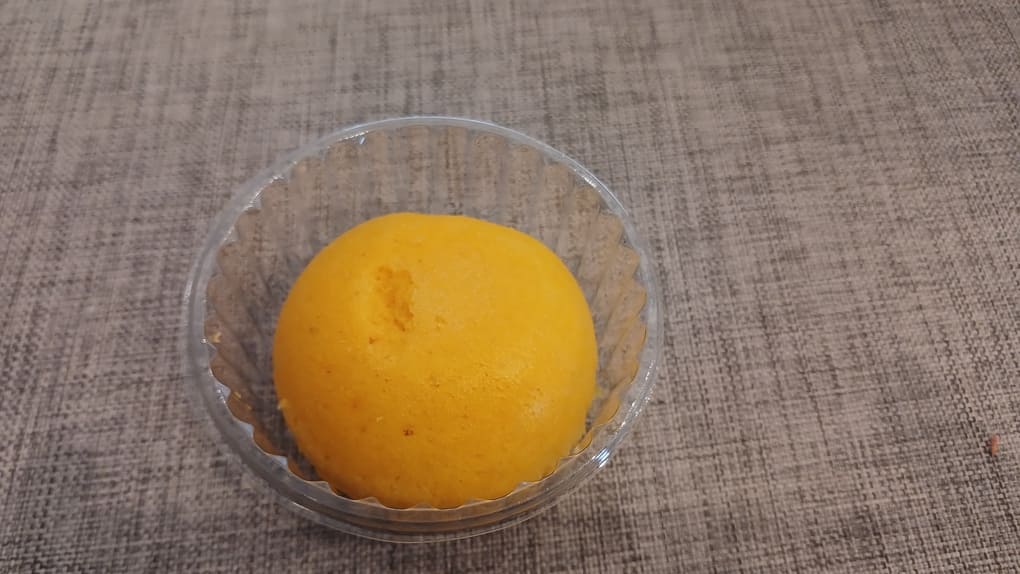
The fillings and flavors used in bakpia kukus are similar to those found in regular bakpia. The most common ones are chocolate, cheese, peanut paste, different fruit fillings, and mung bean paste.
Bakpia kukus is often considered a more indulgent and melt-in-the-mouth treat and the price of ~45.000 IDR (3$) for a box of 10 reflects that.
Simon’s taste score: 9/10.
3. Pie Susu

With a name that translates to “milk pie”, this Indonesian dessert is something like a creme caramel inside a thin pastry shell.
The mixture inside is made from condensed milk, egg yolks, and sometimes additional flavorings like vanilla or pandan.
It is a favorite souvenir for tourists visiting Bali and other Indonesian islands.
One pie susu costs around 3.500 IDR (0.25$) but they are commonly sold in a box of 10 for 25.000 IDR (1.6$).
Simon’s taste score: 8/10.
4. Carica

Carica is a baby papaya. In the case of the dessert, carica is a watery jam of baby papayas.
Making carica involves peeling and thinly slicing the young papaya, then boiling it in a sugar syrup until it becomes candied and translucent. The resulting candied papaya is sweet, with a slightly chewy texture.
Carica itself grows in the higher regions of Central Java and is most famous as a souvenir to take when visiting the Dieng Plateau.
One cup of the original high-quality carica costs 3.000 IDR (0.2$).
Simon’s taste score: 7/10.
Indonesian Desserts Best Consumed Warm
This selection of treats contains those that are prepared by street vendors on the spot and go into your hand hot. They are to be consumed as soon as possible while they’re fresh and still warm.
5. Kue Cubit

Kue is the Indonesian word for “cake” and you will see it way too often in this list. That is because many desserts are considered a type of cake even though they are far different than the circle-shaped layered cake we’ve come to know well.
Kue cubit means “pinch cake”, because of the way it’s prepared – small cups of baked dough pinched or grabbed with a pair of tongs.
They are often cooked until they have a slightly crispy outer layer while remaining soft and moist on the inside. Kue cubit comes in a variety of flavors like chocolate, cheese, condensed milk, etc.
One piece costs around 2.000 IDR (0.15$).
Simon’s taste score: 9/10.
6. Kue Pukis
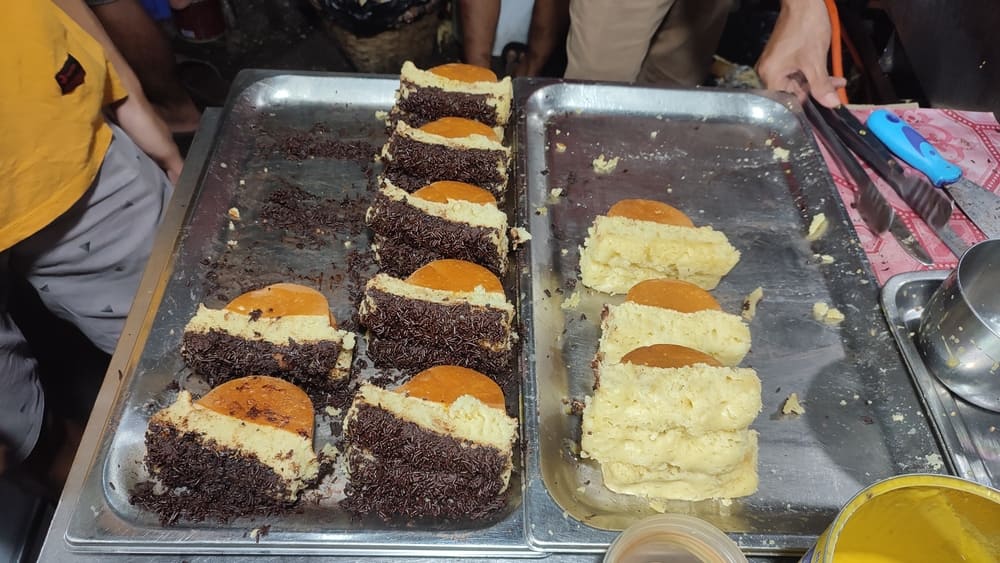
Kue pukis is a type of small, sweet, and slightly fluffy cake that is often cooked in a unique, half-moon, or fish-shaped mold.
It is usually cooked in special greased molds, where the batter is poured. As the cakes cook, they develop a crispy, golden-brown exterior while remaining soft and slightly chewy on the inside.
Smaller variants of kue pukis sell for 3.000 IDR (0.2$) whereas bigger ones, like in the picture above, go for 8.000 IDR (0.5$).
Simon’s taste score: 10/10.
7. Roti Bakar
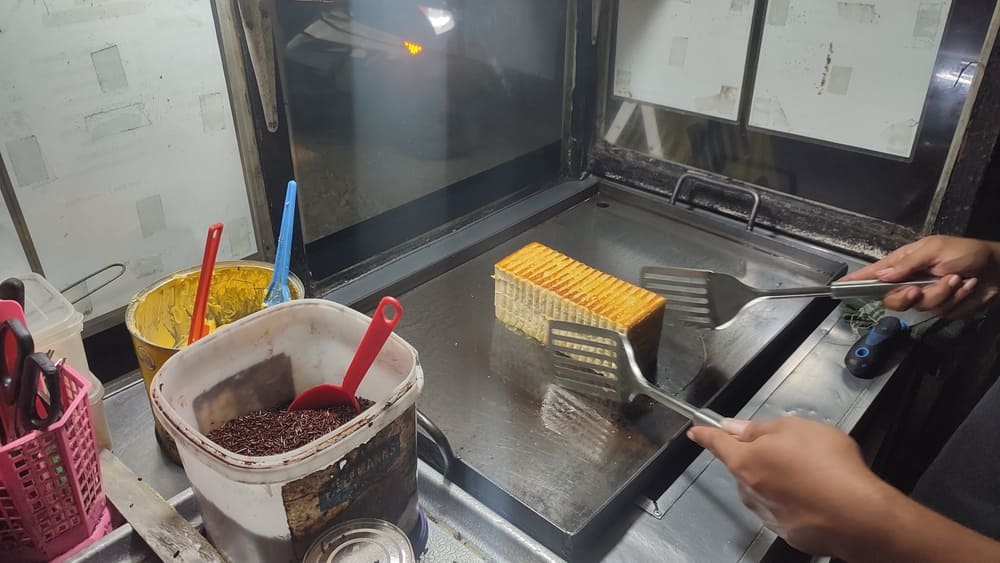
Roti bakar, literally “grilled bread”, is exactly the type of dessert that you’d do at home at 2 in the morning when you crave something sweet.
In Indonesia you won’t have to – it’s readily available at street vendors around any city.
Roti bakar consists of 2 slices of bread (cut on the long side) that are grilled or toasted and then spread with various sweet or savory toppings.
Prices vary by flavor but expect to pay between 12.000 and 20.000 IDR (0.8 to 1.3$).
Simon’s taste score: 8/10.
8. Martabak Manis (aka Terang Bulan)
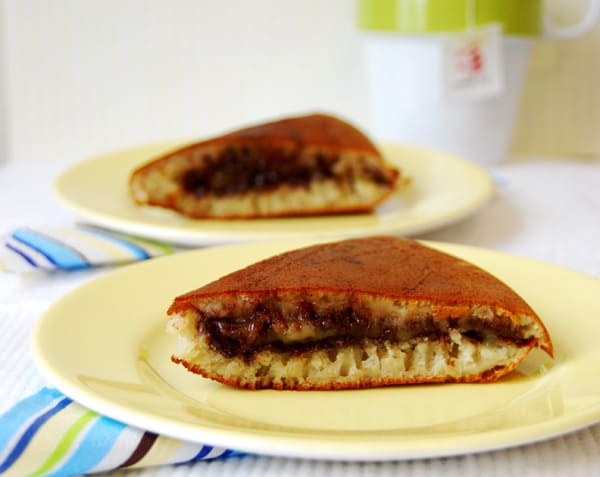
Martabak manis is a sweet and indulgent pancake filled with a variety of sweet fillings like chocolate chips, cheese, condensed milk, crushed peanuts, or a combination of these.
The fillings are added to the pancake before it’s folded.
Now let’s address the name situation. Martabak comes from the Arab World and the name has traveled to Indonesia due to its Islamic roots.
In many places in Indonesia however, the dessert is called “Terang Bulan”, which translates as “Bright Moon” due to the pancake’s shape when it’s folded. I kinda like this name more – it’s so beautifully descriptive!
Martabak manis / Terang bulan is a big dessert and the price for one is between 18.000 and 25.000 IDR (1.2$ – 1.6$).
Simon’s taste score: 8/10.
9. Serabi

Serabi is a pancake-like dessert made from rice flour and coconut milk. It has a slightly sweet, chewy, and sometimes slightly crispy texture.
Serabi comes from one of my favorite Javanese cities – Surakarta, but you can find it in many places around Indonesia.
One serabi costs around 4.000 IDR (0.25$).
Simon’s taste score: 9/10.
10. Donat
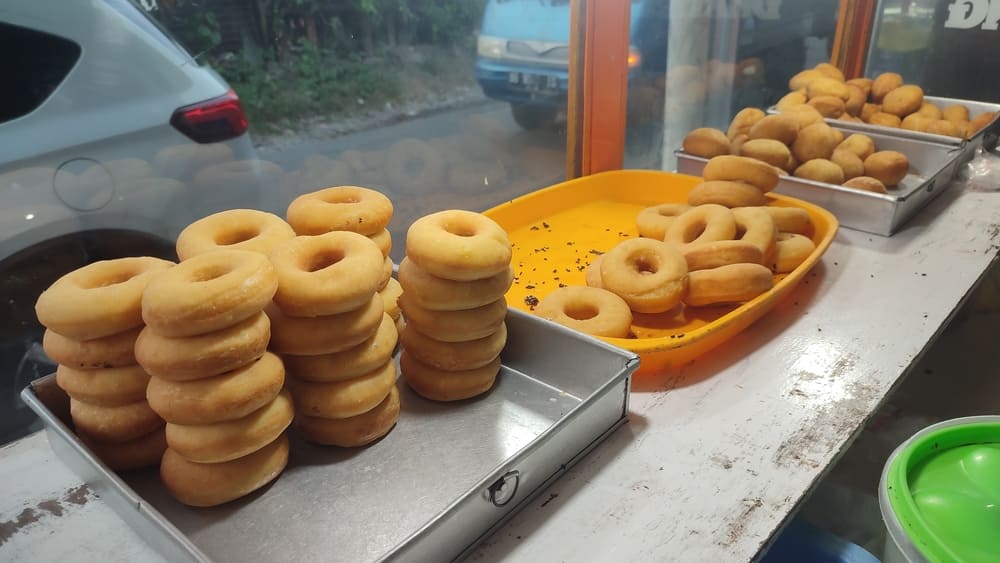
No, I did not make a spelling mistake! Donat is the Indonesian spelling and “donat donat” is the plural!
And no, I’m not talking about your fancy Dunkin Donuts. The simple Indonesian donat is one of my favorite sweet snacks.
The classic one is just a ring powdered with some sugar but there are ball-shaped ones filled with chocolate or keju (cheese).
One donut costs ~1.500 IDR (0.1$).
Simon’s taste score: 7/10.
11. Leker
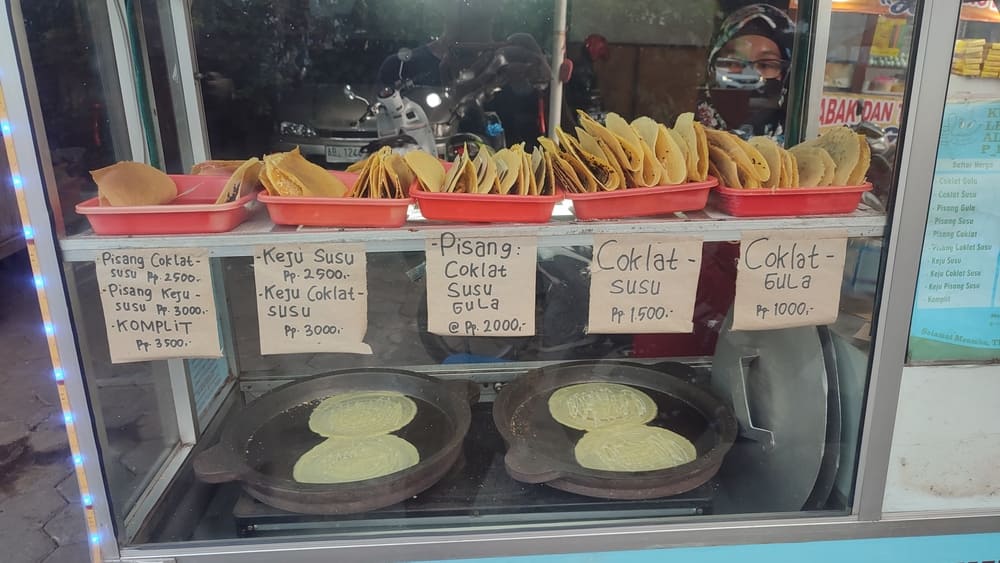
Leker is one of the most popular Indonesian desserts. It is a crispy and thin crepe, made from a batter of flour, eggs, coconut milk, and sugar. The batter is poured onto a hot griddle or skillet and cooked until it becomes crispy and slightly browned.
The fillings for leker can vary widely, but for the sweet version, common fillings include chocolate sprinkles, grated cheese, condensed milk, and sometimes crushed peanuts or bananas.
One leker costs around 2.000 IDR (0.15$).
Simon’s taste score: 7/10.
12. Kue Rangi

Kue Rangi is made with a mixture of desiccated coconut with palm sago. Palm sago is the starchy substance extracted from the pith (center) of the sago palm tree. The use of palm sago makes the dough chewy.
Kue rangi is cooked without oil. Instead, it’s baked over charcoal which gives it a unique slightly-burnt taste. Then, to give it sweetness, melted brown sugar is smeared on top.
It originates from the Betawi region (in and around Jakarta) and is most popular in West and Central Java.
One piece of kue rangi costs around 2.000 IDR (0.15$).
Simon’s taste score: 5/10.
13. Molen

Molen are deep-fried pastry rolls typically filled with something sweet inside. They have a thin and crispy outer layer. The most common fillings are banana, chocolate, or cheese.
They are sold by street vendors and oftentimes allowed to cool down. But they are just not that tasty if not warm. Look for the steam on the windows or ask if they’re fresh and still warm. If cold, my “Simon’s taste score” drops down by 3 points.
One molen is usually 500 IDR (0.03$).
Simon’s taste score: 5/10.
14. Kue Putu

Do not mix up kue putu with kue putu ayu (from the next section) as they are pretty different from each other.
Kue putu, also known as Putu Bambu, is known for its cylindrical shape and its sweet, fragrant filling, often made with palm sugar and coconut.
When the kue putu mixture of rice and tapioca flour is ready, it’s folded in a cylindrical shape and wrapped in bamboo tubes.
These tubes are then set upright on a steamer. As the Kue Putu steams, it cooks and forms a soft, slightly chewy texture. When ready, the bamboo tubes are unrolled and the dessert is served.
Kue putu is best served hot, right off the steamer.
One kue putu costs 1.000 IDR (0.06$).
Simon’s taste score: 6/10.
15. Pisang Goreng

Rusgun (CC BY-SA 3.0)
Pisang goreng, or deep-fried bananas, is so stereotypically Indonesian! Every Indo grandma cooks this sweet snack at home and it’s widely available at street vendors and warungs.
The key to a successful pisang goreng is to use Pisang Ambon or Pisang Raja varieties of the banana and to only use well-ripened ones.
It’s enjoyed warm right off the frier but is good later when it’s cooled down too.
If you go for a fancier pisang keju portion (banana+cheese), you must eat it warm when the cheese on top melts.
A single pisang goreng costs 1.000 IDR (0.06$), whereas a portion of pisang keju with 3-4 bananas is usually around 8.000 IDR (0.5$).
Simon’s taste score: 8/10.
Indonesian Desserts Tasty at Room Temperature
In this section, I will list the sweet snacks that you can enjoy even after they’ve cooled down. In some situations, they are even better like that!
Some desserts here are usually wrapped in plastic and sold individually. However, you can’t take them with you back home, thus I don’t think they can be considered ‘packaged’.
16. Onde-onde
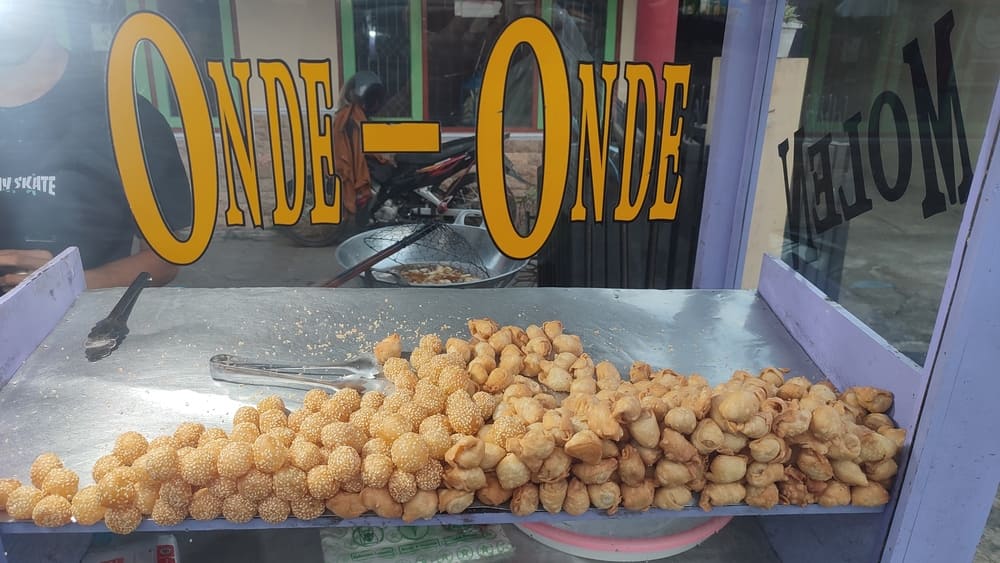
Onde-onde is a popular Indonesian and Malaysian sweet snack or dessert. These bite-sized treats are made from glutinous rice flour, filled with palm sugar (known as gula melaka in Malaysia and gula aren in Indonesia), and coated with sesame or in some variations – grated coconut.
The result is a chewy and slightly sticky outer layer and a sweet burst of palm sugar inside.
One ball of onde-onde usually costs 500 IDR (0.03$).
Simon’s taste score: 7/10.
17. Dadar Gulung

With a name that translates as “rolled omelet”, you’d expect a main meal. However, Dadar Gulung is just a small rolled pancake filled with sweet coconut and palm sugar.
It is known for its vibrant green color, usually derived from pandan leaves.
Dadar gulung can be found in more traditional markets in Indonesia and costs around 3.000 IDR (0.2$) per piece.
Simon’s taste score: 7/10.
18. Kue Mata Kebo (or Kerbau)

This circular red dessert is one I expected to like when I saw it, but in reality is one of my least favorite on the list.
With a name that literally means “buffalo eye cake”, I should’ve seen it coming, although it’s just a reference to its unique look.
Kue Mata Kebo is made from glutinous rice flour, sugar, and coconut milk, which are combined to form a sticky and elastic dough. Inside it’s filled with either a paste of green beans or coconut.
One piece costs around 3.000 IDR (0.2$).
Simon’s taste score: 3/10.
19. Wajik

Wajik translates as “diamond” due to its diamond-shaped pieces (although, as you can see in the picture, it comes in rectangles too).
It is made primarily from glutinous rice giving it a sticky and chewy texture. To achieve this, the cooked glutinous rice is typically flavored with coconut milk and palm sugar.
Wajik is often enjoyed as a snack or dessert at weddings, celebrations, and special events in Indonesia. It is a symbol of good luck and is believed to bring happiness and prosperity.
One wajik costs around 3.000 IDR (0.2$).
Simon’s taste score: 5/10.
20. Gethuk
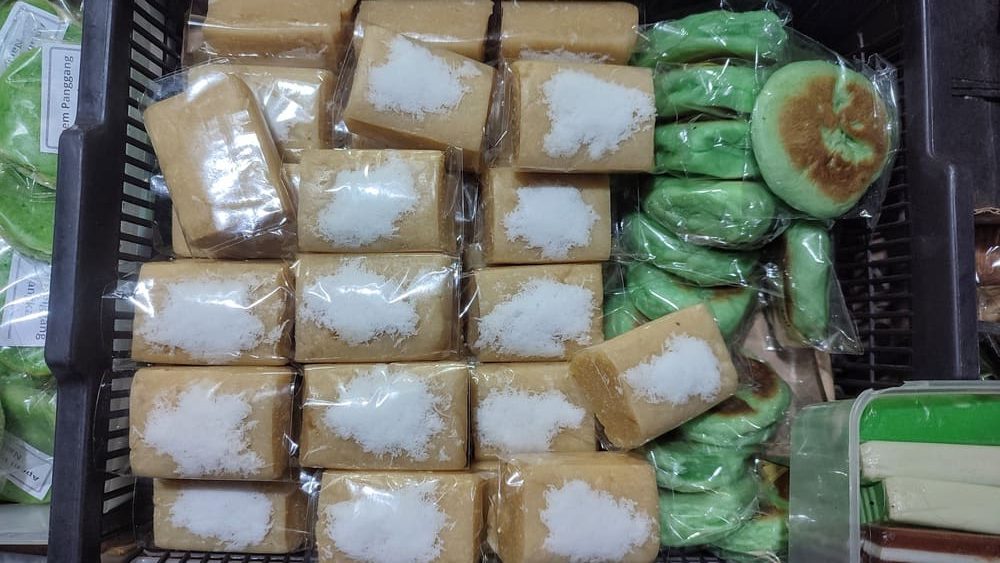
Gethuk is another dessert whose translation will make you go “aaah“. This time it comes from Javanese where it means simply “fat”.
Gethuk is made from cassava (tapioca) and coconut, resulting in a sweet, sticky, and chewy treat. It’s sprinkled with desiccated coconut on top. Not as fat as the name suggests, but not too far off either.
I have to confess I don’t like gethuk all that much – it’s way too dry for my palate, owing to the tasteless cassava that’s used in its preparation.
One gethuk costs around 3.000 IDR (0.2$).
Simon’s taste score: 3/10.
21. Apem Panggang
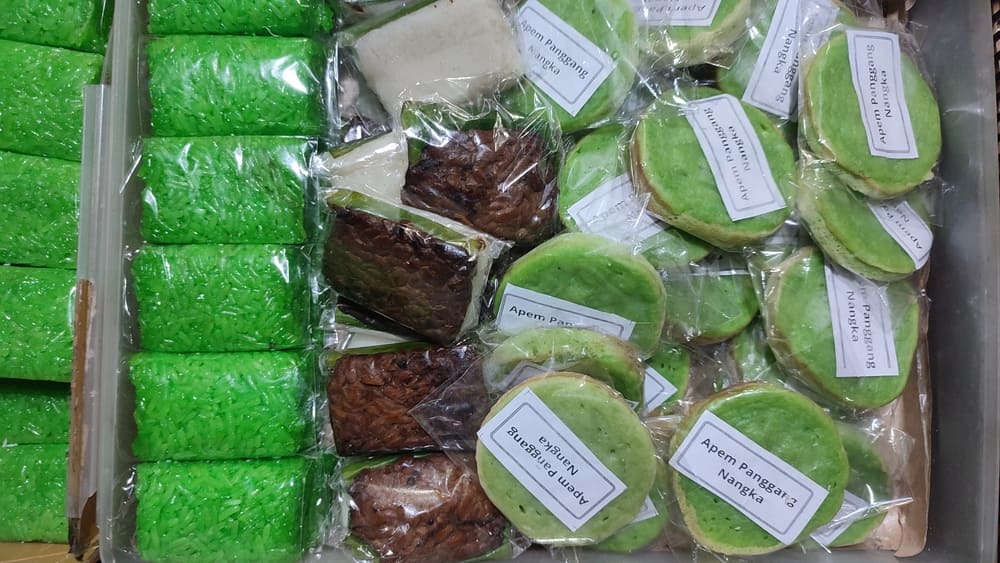
Apem Panggang is a type of pancake made from a batter that typically includes rice flour, coconut milk, sugar, and a leavening agent, such as yeast or baking powder. It is roasted, unlike its brother Kue Apem (next one on the list), which is steamed.
It is usually mixed with some other flavor or fruit, as in the picture above where the variation uses jackfruit, the biggest fruit in the world (and quite tasty on its own).
Apem Panggang costs 3.000 IDR (0.2$) per piece.
Simon’s taste score: 6/10.
22. Kue Apem
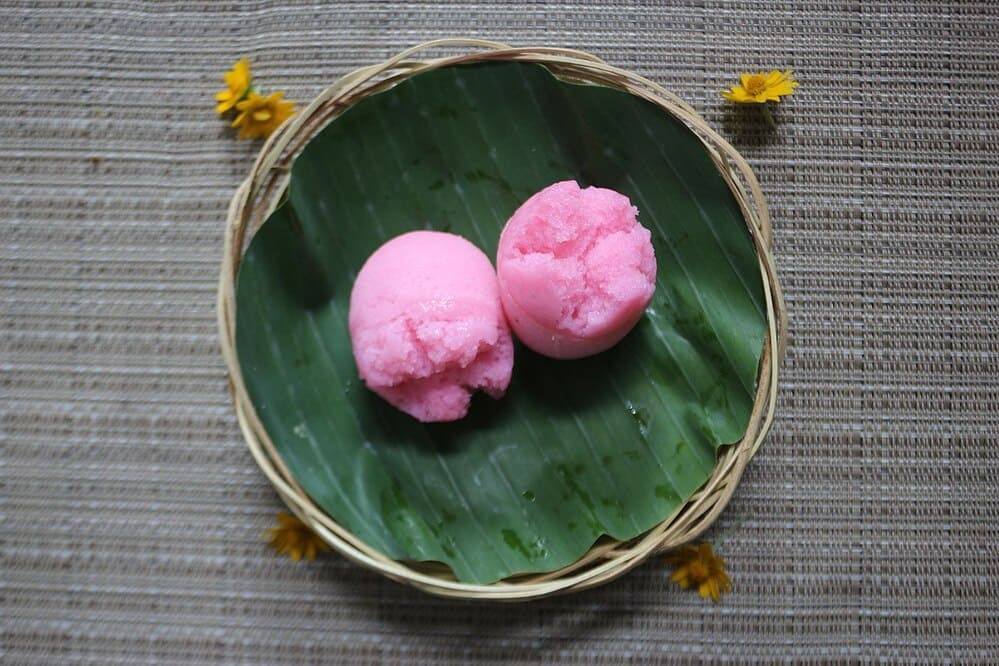
Kue Apem is very similar in mixture and texture to Apem Panggang, even if the pictures don’t show it. The main difference is that apem panggang is roasted whereas kue apem is steamed.
Other than that, it’s the same combination of rice flour, coconut milk, and sugar.
Same price as well – usually 3.000 IDR (0.2$) per piece.
Simon’s taste score: 7/10.
23. Roti Kukus
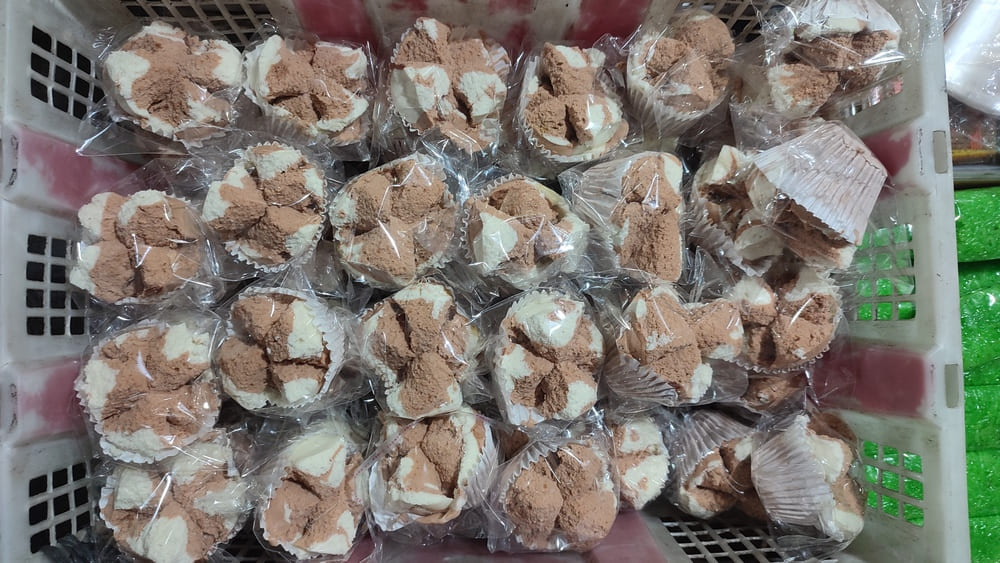
Now, before you experience a weird dessert deja vu and say roti kukus is the same as kue apem, consider that, well, they almost are. The main difference is the ingredients – kue apem uses rice flour but roti kukus uses wheat.
Roti kukus is a bit drier too, and I found it a bit sweeter as well. If I have to choose between the two, my vote goes to kue apem.
One roti kukus goes for 3.000 IDR (0.2$).
Simon’s taste score: 6/10.
24. Bikang
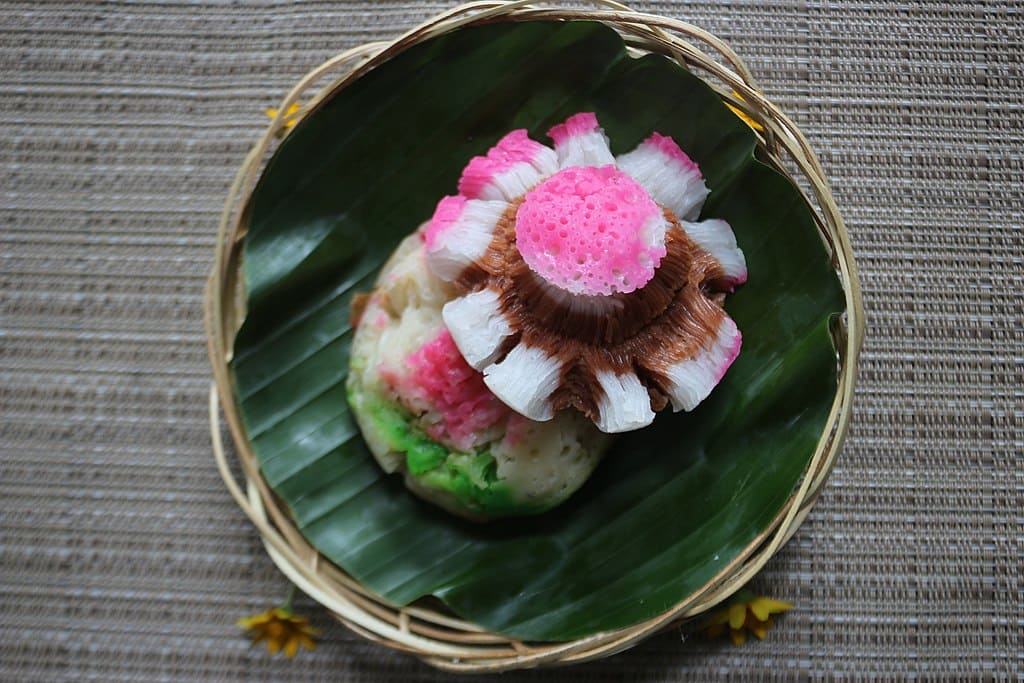
Bikang looks an awful lot like if you mixed kue apem and roti kukus. It is sweet and dense and comes in a variety of variants:
- Bikang Ambon: Spongy and fluffy often with a bright yellow color and a sweet, fragrant aroma.
- Bikang Mawar: Looks and tastes like a rose. Just like in the picture above.
- Bikang Tanduk: Shaped like a horn or cone.
- Bikang Susu: Includes condensed milk as one of its key ingredients. It has a sweeter and creamier flavor compared to other types of Bikang.
One bikang costs around 3.000 IDR (0.2$).
Simon’s taste score: 7/10.
25. Kue Putu Ayu

Putu ayu cake is known for its delightful appearance, which includes a green, cylindrical cake topped with grated coconut and a center made to resemble a flower bud.
Just look at it – doesn’t it make you want to eat it?
The main ingredients are rice flour, tapioca flour, coconut milk, sugar, and pandan leaves for flavor and color. Pandan leaves give the cake a pleasant green hue and a fragrant aroma.
It’s topped off with grated coconut.
The best thing about it is that it has a liquid center. Bite into it and you will feel the palm sugar.
Like similar items on the list, one kue putu ayu only costs 3.000 IDR (0.2$).
Simon’s taste score: 6/10.
26. Wingko (Wingko Bbabat)
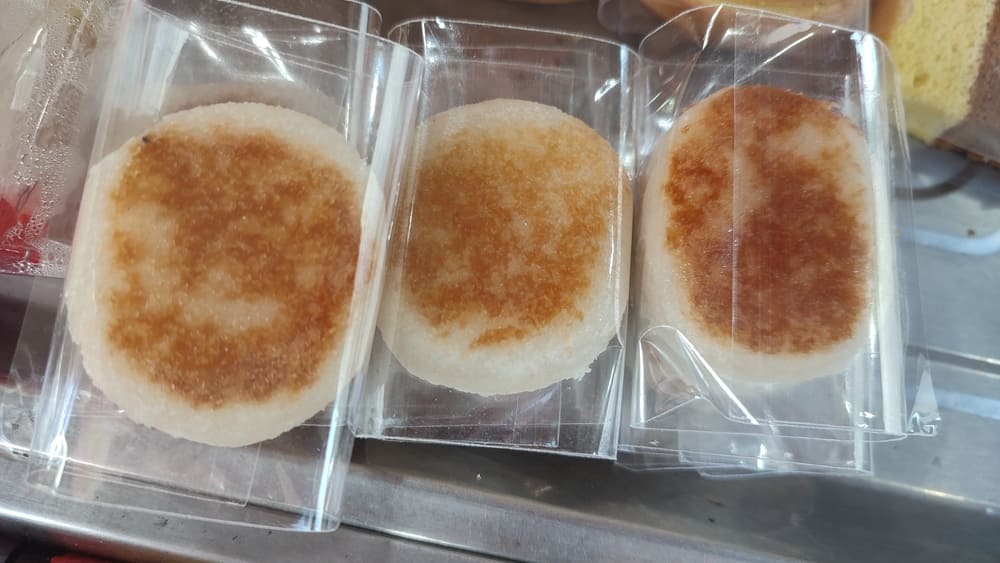
Continuing the trend of pancake-themed or shaped or tasting-like Indonesian desserts, we have wingko (or wingko babat) – a dessert that I was surprised to find out doesn’t give you wings.
Wingko is coconut-based, made from grated coconut, coconut milk, and coconut sugar (gula kelapa). It is baked in a round or square shape and has a crispy, golden-brown crust on the outside.
Indonesians associate it with celebrations, special occasions, and holidays.
One wingko costs around 3.000 IDR (0.2$).
Simon’s taste score: 6/10.
27. Kue Lumpur
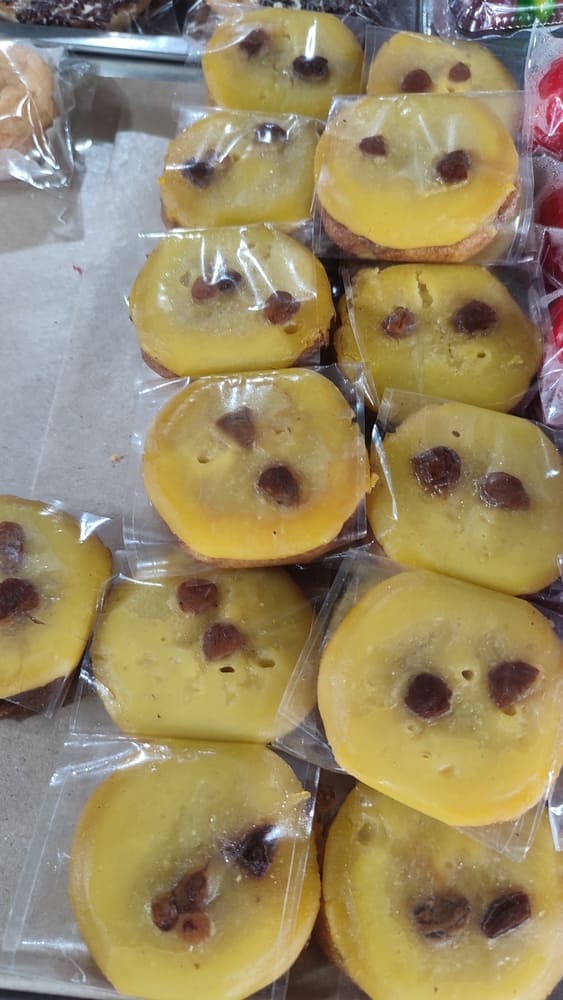
Kue Lumpur’s name means “mud cake”. You know, like Kuala Lumpur, the “muddy confluence” city in Malaysia.
The name is due to its soft, pudding-like texture. It’s another one of these Indonesian desserts made with rice flour and is appreciated for its sweet, almost creamy taste.
One kue lumpur goes for 3.000 IDR (0.2$).
Simon’s taste score: 8/10.
28. Lopis
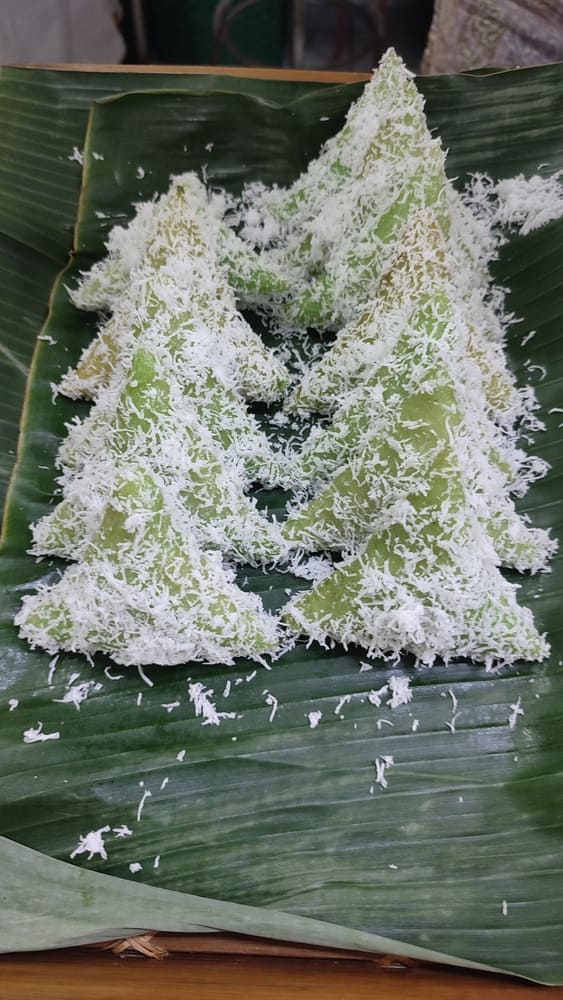
Lopis is a glutinous rice dessert with a liquid filling of caramelized brown sugar. It’s usually coated in coconut.
The traditional way to keep lopis is to wrap it in a banana leaf, but as you can see in the picture above, it’s also sold naked.
One lopis costs around 5.000 IDR (0.34).
Simon’s taste score: 7/10.
29. Klepon
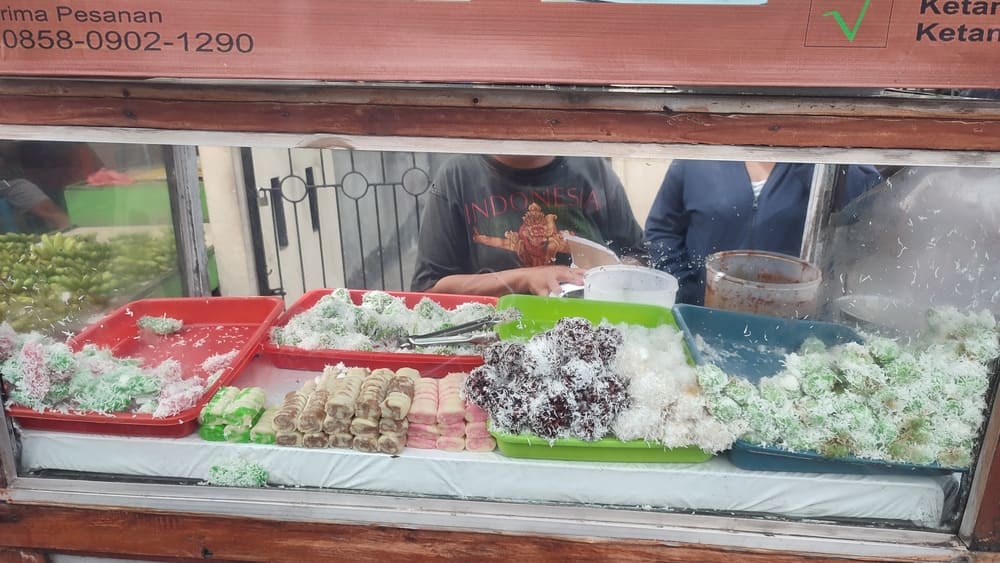
Klepon is practically the same as lopis, just smaller. Whereas lopis are shaped in relatively big triangles, klepon are small bite-sized balls coated in the same grated coconut. The filling is the same – liquid brown sugar.
One klepon costs 1.000 IDR (0.06$).
Simon’s taste score: 7/10.
30. Kue Talam
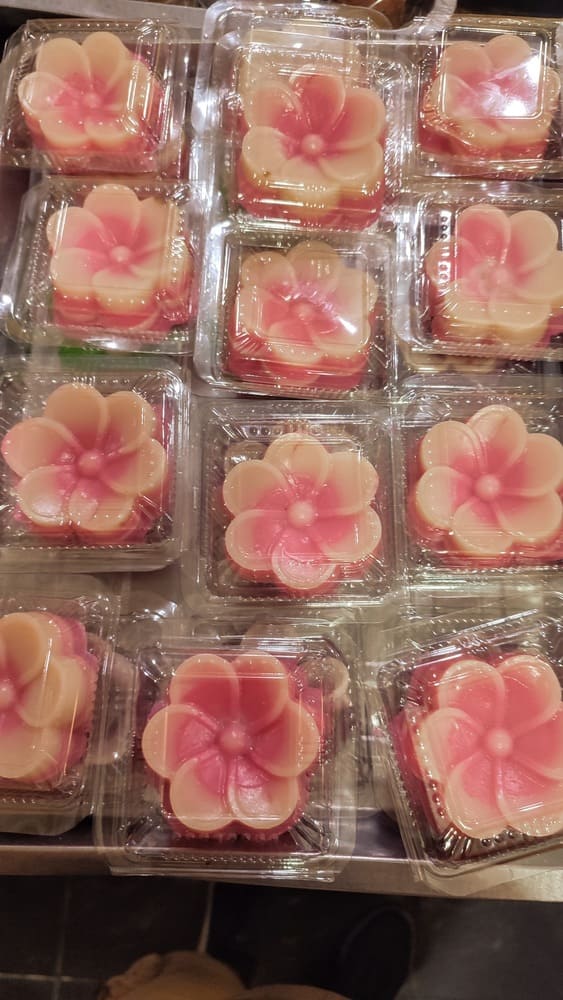
Kue Talam is known for its distinctive two-layered appearance, with a white, coconut-flavored layer on the bottom and a colored, flavored layer on top. The flavors can vary, with the most common ones being pandan (green) or rose (red, shown above).
Kue Talam is rice-based and steamed. It has a dense, sweet, and slightly chewy texture.
One kue talam costs 4.000 IDR (0.25$).
Simon’s taste score: 6/10.
31. Kue Lapis

Kue Lapis, also known as “Layered Cake” or “Kue Pepe,” is a traditional Indonesian sweet snack known for its visually striking, multi-layered appearance, reminiscent of a rainbow.
It’s made with rice flour, coconut milk, sugar, and food coloring. Pandan leaves or pandan extract may be used to add a green layer and a subtle pandan flavor.
In terms of texture, kue lapis is jelly-like, thick but soft.
One piece costs 3.000 IDR (0.2$).
Simon’s taste score: 6/10.
32. Nagasari

Nagasari is a sweet rice cake filled with a mixture of banana and coconut, often wrapped in a banana leaf.
Nagasari is steamed and comes in green or white depending on the colorant.
The name means “Beautiful dragon” in Indonesian.
One nagasari usually costs 4.000 IDR (0.25$).
Simon’s taste score: 6/10.
33. Agar agar
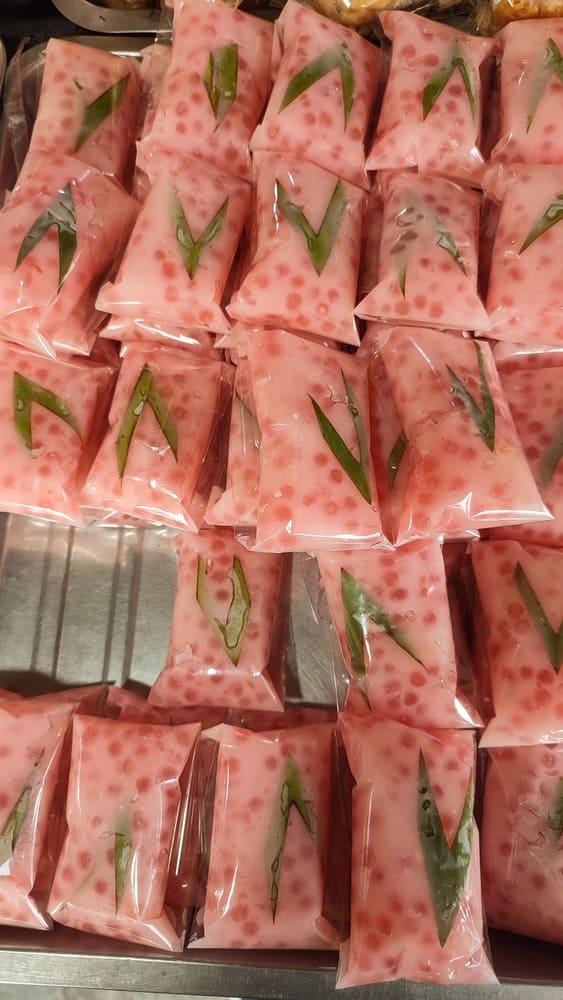
Agar agar is a type of jelly-like dessert made from agar, a gelatinous substance derived from seaweed. You know, like in the hyper-popular internet game agar.io, but not like the agar plate that scientists use to grow bacteria – this one is yuk.
Agar Agar is smooth and wobbly and comes various flavors.
The main ingredient, agar agar, is obtained from seaweed and comes in the form of translucent, tasteless strands, flakes, or powder. It is a vegetarian alternative to gelatin and is used to thicken and set the dessert.
Once flavored though, the dessert is pleasantly smooth and sweet.
One agar agar costs around 3.000 IDR (0.2$).
Simon’s taste score: 6/10.
34. Kue Putu Mayang
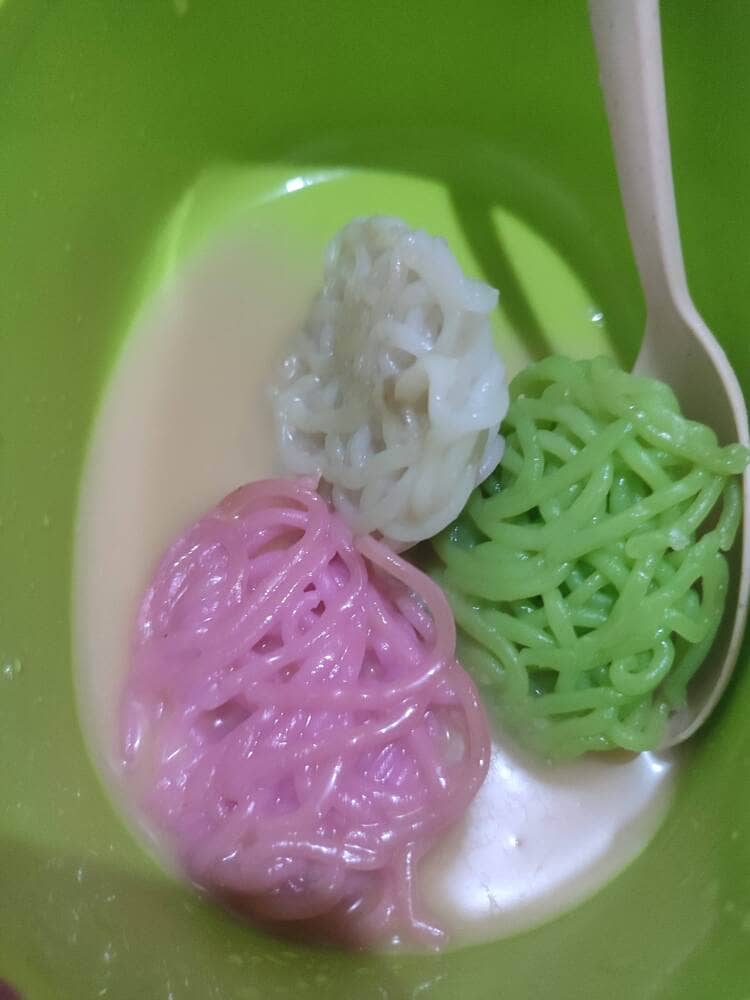
Kue putu mayang, or what I like to call “sweet spaghetti” is one of the weirdest-looking Indonesian desserts. It all begins when rice flour (of course), water, some salt, and oil are mixed to create the batter. The batter is often tinted with natural food coloring to give it a green or red color.
Then comes the tricky part which is the reason you probably can’t make kue putu mayang at home: The batter is poured into a special cylindrical mold or press with tiny holes at the bottom (called a murukku press).
The mold is then placed in a steamer. As steam passes through the holes, it forms thin, noodle-like strands of rice flour that are cooked by the steam. The sweet spaghetti.
Since these strands are tasteless on their own (it’s basically just rice), a sweet mixture of palm sugar, pandan leaves, and grated coconut is poured over them.
A standard package includes 3 “nests” of sweet spaghetti and costs around 5.000 IDR (0.3$).
Simon’s taste score: 9/10.
Liquid Indonesian Desserts
In this section, you will find desserts that resemble sweet soup. They are to be eaten with a spoon at a warung, angkringan, or on a small chair next to the street vendor who sells it.
35. Es Dawet
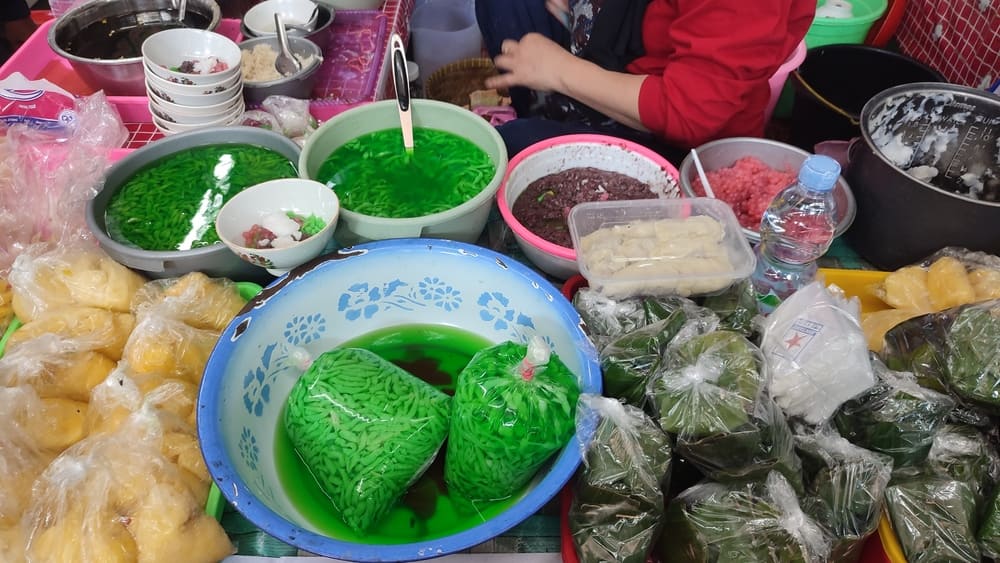
Es dawet is unlike anything I’ve ever seen in the world of desserts. The sheer number of ingredients made my jaw drop when I saw it being prepared for the first time.
The main ingredient is a green, worm-like jelly made from rice flour and sago palm flour.
Additions vary, but the most common ones are, mung beans, jackfruit, grass jelly, and crushed ice. A bunch of mystery ingredients too. Everything floats in coconut milk.
Es dawet is to be eaten cold right after preparation.
It’s super popular in Central Java, especially in the city of Surakarta.
A bowl of the standard variety of es dawet costs 8.000 IDR (0.5$).
Simon’s taste score: 9/10.
36. Wedang Ronde
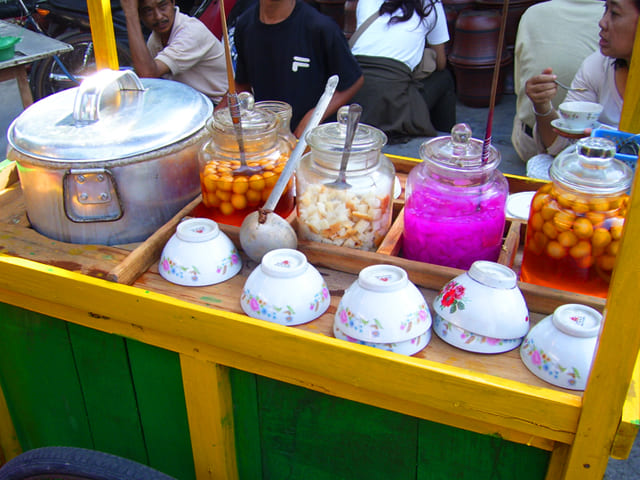
Remember onde-onde? Remove their sesame seeds, boil them in gingery water, pour palm sugar syrup on top, and voila, you get wedang ronde.
It is served warm and its taste combines the chewy texture of the rice balls, the warmth of the ginger infusion, and the sweetness of the palm sugar syrup.
It’s a bit spicy because of the ginger, so beware!
A portion of wedang ronde costs 10.000 IDR (0.65$).
Simon’s taste score: 5/10.
Cold Indonesian Desserts
In this section, you will find desserts that are best eaten cold.
37. Kue Sus
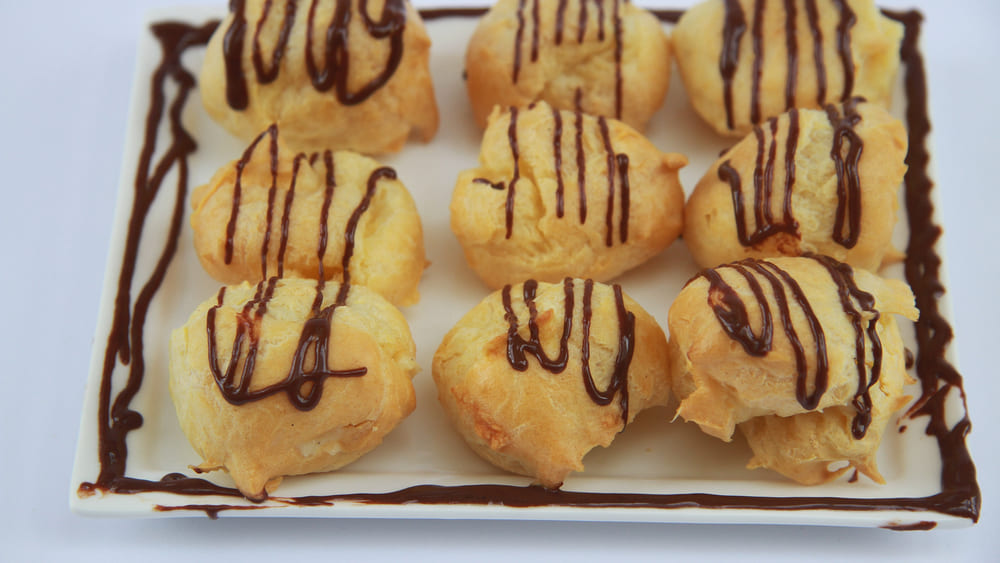
If you think you’ve seen kue sus before, you’re probably right. It’s pretty much the Indonesian variant of profiteroles, also known as choux pastry or cream puffs.
This suspicious cake (get it, because it’s ‘sus’… okay I’ll let myself out) is prepared much the same way as profiteroles or eclairs.
A mixture of water, butter, flour, and eggs is piped into small mounds on a baking sheet and then baked until it puffs up and becomes hollow on the inside.
They are then allowed to cool and filled with a sweet cream or custard filling.
Kue sus is then dusted with powdered sugar or topped off with chocolate. For the best taste, consume refrigerated.
One kue sus costs 2.000 IDR (0.15$).
Simon’s taste score: 9/10.
38. Kocok
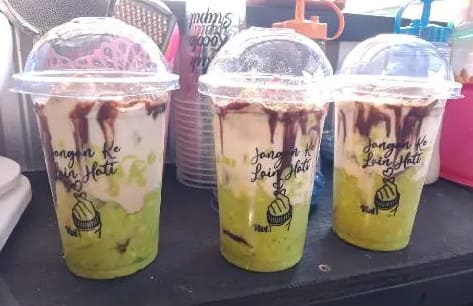
Kocok means “to shake” and it is pretty similar to what “My Little Pony” made us believe is a real shake.
The most common variants are Alpukat Kocok (with avocado) and Durian Kocok (with the smelly Southeast Asian fruit that foreigners are scared of).
Very ripe fruit is used to prepare kocok, mixed with plenty of condensed milk and ice cubes. The result is a frothy, creamy, cold, and incredibly sweet dessert. Often a little liquid chocolate is poured on the sides of the cup before adding the main drink from the mixer.
One alpukat or durian kocok costs 10.000 IDR (0.6$).
Simon’s taste score: 7/10.
39. Rujak Es Krim
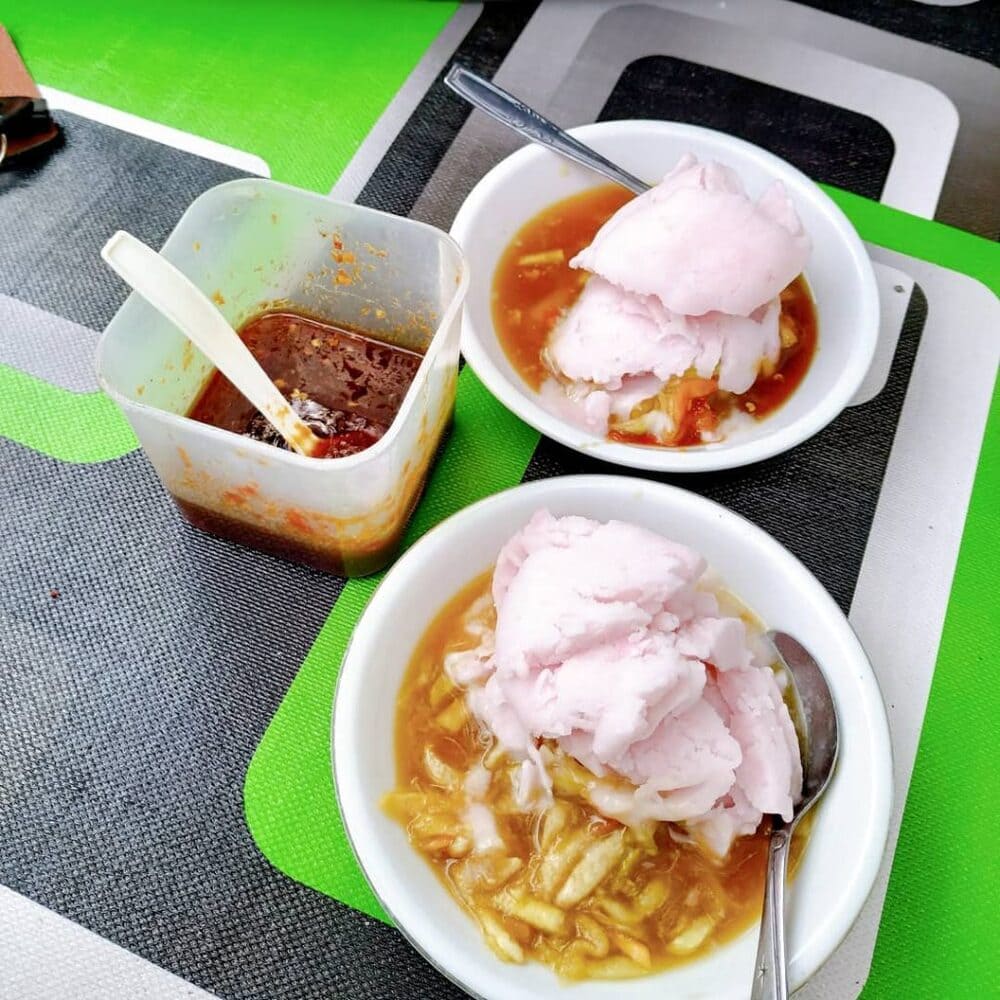
“Rujak es krim” is an Indonesian dessert that combines elements of two different dishes: “rujak” and “es krim.”.
You probably already suspect what “es krim” means and are correct – it’s basic ice cream.
Rujak on the other hand is a tropical fruit salad such as mango, pineapple, papaya, melon, rose apple (jambu), etc.. The fruits are cut into bite-sized pieces and then dressed with a sweet and spicy sauce made from palm sugar, tamarind, chili, and other ingredients.
In this dessert, you typically find a scoop or two of ice cream served alongside or on top of the rujak.
Rujak Es krim is very popular in the city of Yogyakarta.
One portion of rujak es krim usually costs around 12.000 IDR (0.8$).
Simon’s taste score: 8/10.
So there you have it – a list of 39 Indonesian desserts, from the fancy-looking ones that you can take home overseas, to the weird ones, and the rare desserts you can only buy at traditional markets.
If you liked this list, you will also like my list of Indonesian street food snacks!
